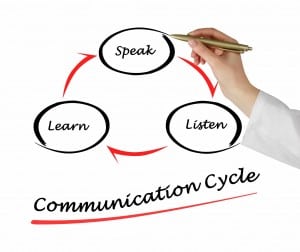
To person A, communications strategy means marketing.
Person B will say Sales methodology.
Person X is not entirely certain, but disagrees with everyone A-through-Y.
We live in a customer-facing, glass-house world. This is only necessary because no one has time to waste on disentangling the truth. Technology is aligning marketing, sales, and services around that truth: the exchange between customer demand and how the business will deliver.
As this transformation progresses, SMBs are recognizing a need for one, simple way for customers and businesses to collaborate. And yes, it’s collaborate, more than buy and sell.
The trouble with consolidating these varying communications needs into that single system comes from… well… communications errors. Each division has different goals, definitions, and expectations. Everyone is accustomed to having his/her/its own way, and everyone digs in and questions: why should I change?
As a communications specialist, we use a division-agnostic approach to communications, which holds the business’ key stakeholders in mind. We ask our customers these 3 simple questions:
What does “communications” mean to you?
What does “communications” mean to your business?
What does “communications” mean to your customers?
These three questions cover the structural demands of your communications strategy – how your customers expect to reach you, and under what conditions – how your workforce expects to communicate with itself – and how you will send and receive messages from both of those key stakeholders.
What kind of data do you need to send and receive? Do you – as was the case with an innovative financial services client – need to communicate face-to-face? Do you need a way to measure interactions? Transfer data?
From these 3 simple questions, an entire strategy can be constructed. The strategy needs to serve the vital needs of each stakeholder. At the same time, the system needs to be as simple as possible – in order to reduce maintenance costs and the possibility of error, as well as facilitate future upgrades if/when the need arises.
Come back next week to take your communications strategy to the next level with CenterpointIT’s 5 Pillars.
Call our business managed IT services department directly at (404) 777-0147 or simply fill out this form and we will get in touch with you to set up a getting-to-know-you introductory phone call.
Fill in our quick form
We'll schedule an introductory phone call
We'll take the time to listen and plan the next steps
11285 Elkins Rd Suite E1, Roswell, GA 30076
© Copyright 2024 Centerpoint IT. All Rights Reserved. Website in partnership with Tech Pro Marketing. | Privacy Policy
Get Immediate Help For All Your Technology Issues (404) 777-0147

If you want our team at Centerpoint IT to help you with all or any part of your business IT, cybersecurity, or telephone services, just book a call.
Fill in your information below to get started today.
"*" indicates required fields
Fill in your information below to schedule now.
"*" indicates required fields
Before your organization commits to 1, 2, 3 or even longer managed IT services contract, understand what you’re getting. Centerpoint IT gives you the facts in our Managed IT Services Buyer’s Guide.
Enter your information below and we’ll send it over.
"*" indicates required fields

We are turning 15 and want to celebrate this milestone with you because without you this would not have been possible. Throughout this year look for special promotions on services and tools aimed at Making IT Simple for You so you can focus on your business.

We are turning 15 and want to celebrate this milestone with you because without you this would not have been possible. Throughout this year look for special promotions on services and tools aimed at Making IT Simple for You so you can focus on your business.
https://calendly.com/centerpoint-it/discovery-call